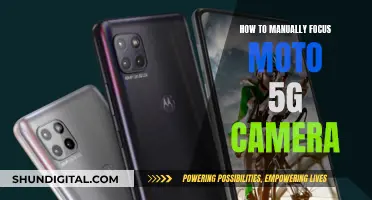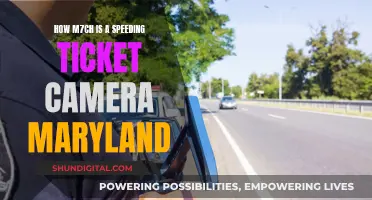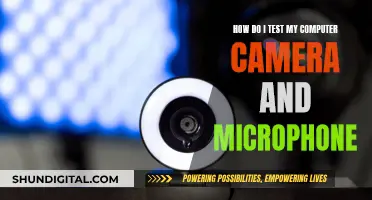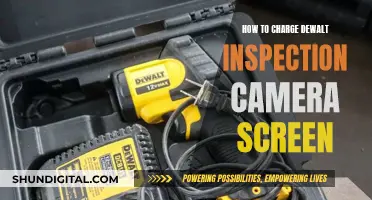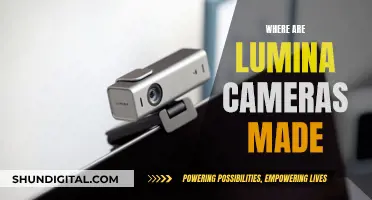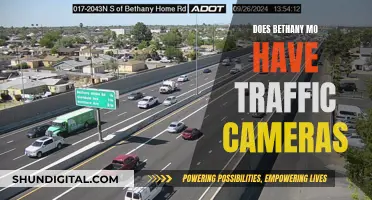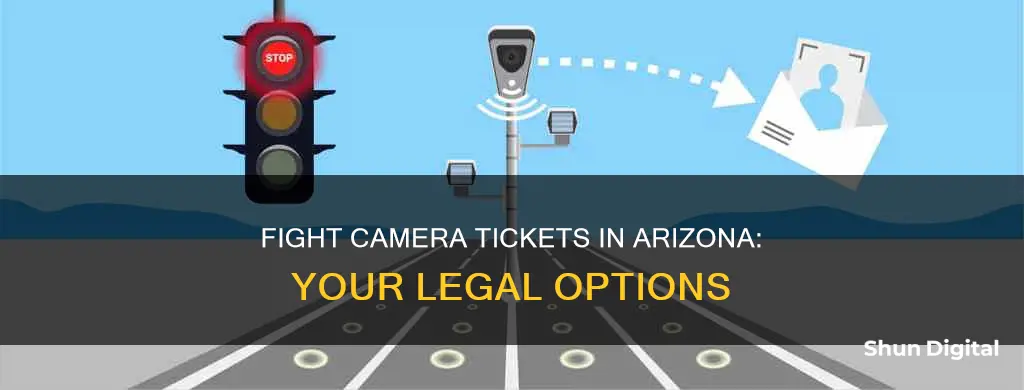
Arizona's photo radar tickets are entirely enforceable, but there are ways to fight them. The Red Light Camera Enforcement Program uses digital cameras and traffic violation detection technology to help reduce the number of people who run red lights. If a driver attempts to run a red light, the camera takes several photographs, along with a brief video. Once reviewed and validated by police, a complaint is issued, and a ticket is sent to the alleged offender.
There are two main ways to receive a radar ticket in Arizona: by mail or in person. If you receive a mailed ticket, you may be able to ignore it if it was not sent and filed by the court, meaning it is not a certified court document. However, the photo radar company can still choose to impose fines if not paid by the deadline, but these cannot be enforced unless filed by the county court.
To serve a citation, the court must first file a violation and hire a process server to give you the citation, either directly or to someone of reasonable age in your home (14 years or older). If the county fails to serve the citation within the specified time limit, you may not have to pay the fine.
| Characteristics | Values |
|---|---|
| Time to receive a photo radar ticket | 60 days from the violation date to file the citation with the courts, then an additional 90 days to serve the citation |
| Mailed ticket | Not a certified court document unless sent and filed by the court |
| Served citation | A process server gives the citation to the recipient or someone of "reasonable age" (14 years or older) in the household |
| Notice of violation | No legal obligation to respond |
| Traffic ticket and complaint | Court case involving the named driver |
| Service of process | Procedure for the State to provide a driver with formal notice of a photo radar ticket |
| Waiver of service | The state no longer has to serve the recipient |
| Alternative service | Used when standard means of service have been unsuccessful. The process server mails the ticket by first-class and certified mail, and posts it to the recipient's front door or garage |
| Fighting a ticket | Requires evidence, e.g. proof of not being in the vicinity at the time of the offence |
What You'll Learn

Ignore the ticket and wait for the 90-day dismissal period to pass
If you've received a photo radar ticket in the mail in Arizona, you may be able to ignore it. According to Arizona law, a ticket must be delivered in person to be valid. This means that if you don't sign a waiver and ignore the ticket, the case will be dismissed after 90 days with no consequences.
However, this strategy is a gamble. If a process server successfully delivers the ticket to you or someone of "suitable age" (14 or older) at your home, you will have to pay the fine, plus an additional fee for the service of process, which is typically around $40 to $100.
To increase your chances of success, you can try to make it seem like no one is home. Keep your car in the garage, shut the blinds, and don't answer the door to strangers. Be aware that process servers may be more persistent in certain cities, such as Scottsdale, which is known for its aggressive photo enforcement program and use of "alternative service". In these cases, they may get permission from a judge to leave the citation at your residence or send it via certified mail.
Additionally, if you are a repeat offender, ignoring tickets may result in an investigation and more serious charges, such as obstruction of justice. Therefore, while ignoring a photo radar ticket for 90 days may result in its dismissal, there is a risk of additional fees and consequences if you are successfully served or if you have a history of violations.
Simplisafe Doorbell Camera: Battery or Wired?
You may want to see also

Argue that the evidence doesn't show what the prosecution says it does
If you are fighting a photo radar ticket in Arizona, you may be able to argue that the prosecution's evidence doesn't show what they say it does.
At a civil traffic hearing, the prosecution will present their evidence against you, including the original ticket, photos and videos of the driver and vehicle, and documents that detail traffic speeds and patterns. They may also detail the nature and conditions of the area, identifying points of interest like nearby parks, schools, and crosswalks.
Once the prosecution has presented their case, it is the defendant's turn to ask them questions about the evidence. After this, the defense can present their own evidence and testimony.
One way to contest the prosecution's evidence is to argue that it doesn't show what they claim. For example, scattergrams are often presented by the prosecution to illustrate the flow of traffic and each vehicle's speed over a period of time. In one chart, the violator vehicle is well above the trigger speed and no other vehicles are traveling near that speed. However, in another chart, the violator vehicle triggered the camera, but was traveling much closer to the speed of other traffic in the area. In this case, the defendant's speed could be considered more reasonable given the circumstances, even if a citation was issued.
Another way to fight a photo radar ticket is to demonstrate that you were not, in fact, the driver. If you have evidence that you were not in Arizona at the time of the violation or that another individual was driving, the court may dismiss the ticket. However, this evidence needs to be substantial. Simply submitting the form on the ticket indicating that you were not the driver is usually not enough.
Hyperlapse Camera Mode: Capturing Time in a Creative Way
You may want to see also

Prove you weren't driving
If you want to fight a camera ticket in Arizona, you must first be served with the ticket. This means that a process server must physically come to your house or place of residence and serve you, or someone of a suitable age (14 or older) who lives with you, with the ticket. If 90 days pass from the date the complaint was filed in court and you have not been served, the ticket will be dismissed.
If you are served with a camera ticket, you can fight it by requesting a civil traffic hearing. At the hearing, the government will present their evidence first, which may include:
- A photograph of the driver and a corresponding photograph from the motor vehicle department
- A document of calibrations or certifications that correspond to the machine
- A video of the infraction
- A scattergram of the traffic speeds
- A histogram of the traffic patterns
The best method for contesting this evidence is to argue that their evidence does not show what they say it does. For example, if a scattergram shows that your speed was much closer to the other traffic in the area, your speed can be considered more reasonable and prudent given the circumstances.
Another way to fight a camera ticket is to prove that you were not the driver. If you have evidence that you were not in Arizona at the time of the violation or that another individual was driving, the court may dismiss the ticket. However, this evidence needs to be substantial. Simply submitting the form on the ticket indicating that you were not the driver is usually not enough.
The Evolution of Camera Manufacturing Origins
You may want to see also

Prove the camera malfunctioned
Proving that the camera malfunctioned is one of the most effective ways to fight a camera ticket in Arizona. Here are some detailed instructions on how to do this:
Firstly, it's important to understand how the cameras work. The cameras are activated by sensors located just before an intersection and are triggered when a vehicle enters the intersection while the traffic light is red. This suggests that one possible malfunction could be the sensors being triggered by something other than a vehicle, such as a glitch or an object that isn't a vehicle. If you have any evidence that the sensors were malfunctioning or were triggered by something other than your vehicle, this could be used in your defence.
Another possible malfunction could be with the camera itself. For example, the camera may fail to capture clear and convincing images or videos of the alleged violation. If the images or videos are unclear, blurry, or do not clearly show your vehicle or license plate, this could be used as evidence of a camera malfunction. Check the images and videos carefully for any signs of distortion, blurriness, or other issues that may call into question the reliability of the camera.
In addition to checking the clarity of the images and videos, pay close attention to the details of the violation captured. For example, examine the images for the position of your vehicle relative to the intersection and the traffic light. If the images show that your vehicle was not actually in the intersection or that the traffic light was not clearly visible from your perspective, this could indicate a malfunction or provide a basis for disputing the ticket.
Furthermore, malfunctions can occur with the timing and synchronization of the cameras and traffic lights. In some cases, the "RTIME" in the photo, which indicates the time the light was red, may be unusually long or inconsistent with the typical duration of a red light. For example, if the "RTIME" shows that the light was red for an unusually long period, such as 10 minutes, this could indicate a malfunction.
Finally, you can request calibration and certification records for the specific camera that issued your ticket. These records should indicate whether the camera was properly calibrated and certified at the time of the alleged violation. If the records show any discrepancies or if the camera was not properly calibrated or certified, this could be strong evidence of a malfunction. You can submit a request for these records to the relevant authorities or the company operating the photo enforcement system.
Remember, when fighting a camera ticket in Arizona, it's important to carefully review all the evidence and look for any discrepancies or signs of malfunction. By following these steps and gathering the necessary evidence, you can effectively prove that the camera malfunctioned and increase your chances of successfully disputing the ticket.
Samy's Camera: Tax-Free Shopping Experience
You may want to see also

Take defensive driving school
If you've received a traffic ticket in Arizona, one option to remedy the violation is to attend an Arizona defensive driving school. This option is only available if you are eligible to attend and you must complete the course at least seven days before your court date.
Defensive driving school is beneficial because points for the violation will not be added to your driving record, your insurance rates will not increase, and you can refresh your knowledge about traffic safety information, driving techniques, and Arizona traffic laws. Additionally, you will not have to make a court appearance in person, and the violation charge will be dismissed.
To be eligible for defensive driving school, it must have been at least 12 months since you last took a traffic school course for a ticket. Your driver's license must not be suspended or revoked, and your violation must be on the list of eligible violations. Serious violations such as reckless driving or driving under the influence are not eligible. You also cannot hold a Commercial Driver's License (CDL) and the citation must not be related to a collision that involved serious injury or death.
To enroll in an Arizona defensive driving school, you must first select a course from the list of Arizona-certified defensive driving schools. You will then need to register for the course and submit identity verification and eligibility documents, which may include a copy of your driver's license, a copy of your traffic citation, an affirmation of eligibility, and course payment. After completing the course, your completion will be reported to the court electronically, and you will receive a certificate of completion for your records.
Unlocking Your Phone: Exiting Camera Mode with Ease
You may want to see also
Frequently asked questions
You may be able to ignore it if it was not sent and filed by the court, meaning it is not a certified court document. However, if you are a repeat offender, there may be an investigation and you could face more serious charges, such as obstruction of justice.
Failure to respond to a served violation can result in a license suspension. Driving with a suspended license can cause further trouble, including 6 months in jail and a fine of $2,500.
You can choose to fight the ticket if you have evidence to prove your case. Your case may go to a civil traffic hearing where the prosecution will present their evidence against you, after which you will have an opportunity to present your evidence and testimony.


